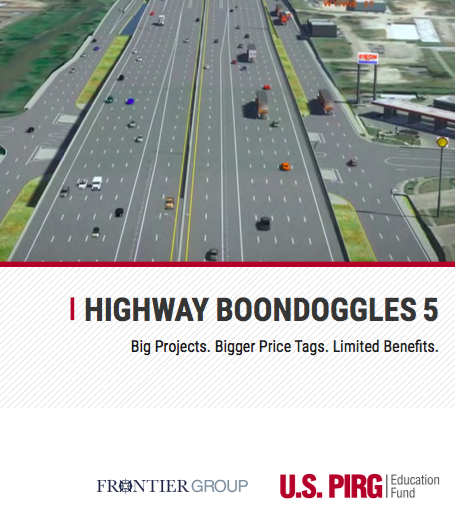What City Observatory did this week
1. It’s official: The Rose Quarter Freeway Widening is a Boondoggle. Frontier Group and USPIRG released the latest version of their annual Highway Boondoggle report, and the Oregon Department of Transportation’s half-billion dollar Rose Quarter freeway widening. The report underscores the verdict from national experts that the project will do nothing to resolve transportation problems, and is at odds with the region’s stated environmental and safety goals.
2. A new measure of the urban economy. The Brookings Institution has a new report measuring the density of employment in the nation’s hundred or so largest metropolitan areas. We’ve long known that the concentrations of workers in cities is a key driver of economic growth: cities promote the interactions among people that generate new ideas and raise worker productivity. The Brookings report adds a new metric, perceived job density, that shows how concentrated employment is within individual metropolitan areas. Their analysis shows that job density has been increasing nationally, with most of the increase being driven by the clustering of information technology and professional services jobs in a handful of superstar cities, including San Francisco, Seattle, and New York. Coupled with other metrics, like job sprawl and median commute distances, the job density measure gives analysts a more precise way to characterize urban form, and measure what matters to metropolitan success.
Must read
1. The New York Times Editorial Board goes YIMBY. Sunday June 16th’s lengthy lead editorial, “Americans’ Need More Neighbors” sounds a lot like a distillation of themes you might have read at City Observatory.
The United States is suffering from an acute shortage of affordable places to live, particularly in the urban areas where economic opportunity is increasingly concentrated . . . Increasing the supply of urban housing would address a number of the problems plaguing the United States . . .allowing more people to live in cities could mitigate inequality and reduce carbon emissions. . . . The loose fabric of single family neighborhoods drives up the cost of housing by limiting the supply of available units. It contributes to climate change by necessitating sprawl and long commutes. It constrains the economic potential of cities by limiting growth. . . . Market rate construction can also help reduce the need for public housing subsidies in the long run. Today’s market rate apartments will gradually become more affordable, just as new cars become used cars.
And, at times, the gray lady sounds even snarkier than an strident urbanist blogger:
. . . advocates for affordable housing should be jumping up and down and screaming for the construction of more high-end apartment buildings to ease demand for existing homes. Those buildings are filled with people who would otherwise be spending Saturdays touring fixer-uppers in neighborhoods newly names something like SoFa, with rapidly dwindling populations of longtime residents.
2. Tolling gets automated. The technology for enforcing and collecting tolls has advanced slowly. Toll booths have slowly given way to electronic systems for reading RFID (radio frequency identification) tags, but these require expensive gantry structures and have to be backed up by optical license plate readers to detect vehicles without tags. The growth of cellular technology, vehicle automation and global positioning systems are likely to further shift the paradigm for toll collection. PayTollo, a subsidiary of satellite radio provider Sirius, has rolled out its cellular/GPS based system for toll payment in several states, including California, Florida and Texas. This technology plugs into the OBD-II port on cars, and using GPS, automatically pays tolls, informing users of charges via smartphone app. Such a system portends tolling that is much more seamless and fine-grained than existing tolling technology. Ultimately, we’re going to need to reflect back to road-users the costs of their decisions to drive on congested roads. This technology points out the way to do that in an efficient fashion.
3. Cities help keep you fit. A new report from the Centers for Disease Control reports Americans are getting slightly more exercise than in previous years, but still far less than is recommended for optimal health. As Time highlights, the built environment plays a key role, and urban residents get more exercise than their rural counterparts:
City dwellers were more likely than rural residents to get enough exercise, according to the new CDC data: about a quarter did, compared to a fifth of people in rural areas. That’s in part because urban environments tend to include sidewalks, bike paths and other resources that make it easier to combine transportation and activity, the report says. Taking public transportation also typically builds some physical activity into a commute, versus driving door to door.
4. Opportunity Zone investment windfalls. The 2017 federal tax cuts established the Opportunity Zone program, a special set of capital gaines tax breaks for investments in depressed areas. ProPublica takes a close look at an Opportunity Zone in Baltimore which will benefit a previously planned project being financed by sports apparel firm Under Armour. In theory, the opportunity zone tax break is supposed to catalyze new investments in distressed areas. But as Pro Publica documents, the Under Armour project has been in the works for years, and their site managed to be designated as an eligible zone, even though it isn’t actually economically distressed. This example underscores how poorly targeted the Opportunity Zone program is in practice, and how its cost will be driven up by forgiving or deferring taxes on investments that would have been made anyhow.
In the News
The Pittsburgh Business Times reported on Joe Cortright’s speech to the National Association of Business, INdustrial and Office Parks (NAIOP) raising concerns about the effects of inclusionary zoning policies.
The Portland Oregonian cited Joe Cortright’s critique of traffic congestion estimates in its story, “Wait, Portland’s traffic improved last year? TomTom navigation company says so.”
Note: This post has been revised to correct errors.


